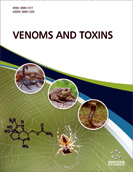
Abstract
Snake envenomations are one of the most common venomous accidents caused by snakes in the world. The symptoms induced after bite vary accordingly to the species. Most of the snake venoms elicit direct or indirect activation of the innate immune responses that ranges from local to systemic effects and contributes to the clinical manifestations after envenoming. The venom interacts with the immune system by inducing the release of damage-associated molecular patterns, which contributes to create a proinflamatory status, release of cytokines and lipid mediators, and has properties to modulate other components of the innate immune system like the complement system. In this review, we highlight some studies that point out over the years the mechanisms by which snake venoms interact with the innate immune system, as well as the pharmacological potential of this class of compounds with great applicability to the medical field.
Keywords: snake venom, inflammation, neutrophils, cytokines, toll-like receptors, complement system
[http://dx.doi.org/10.1042/EBC20160017] [PMID: 27784777]
[http://dx.doi.org/10.1038/nature06246] [PMID: 17943118]
[http://dx.doi.org/10.1016/j.jaci.2009.12.980] [PMID: 20176265]
[http://dx.doi.org/10.3109/08830185.2010.529976] [PMID: 21235323]
[http://dx.doi.org/10.1016/j.toxicon.2019.06.219] [PMID: 31228480]
[http://dx.doi.org/10.1038/s41467-020-19232-8] [PMID: 33116136]
[http://dx.doi.org/10.1073/pnas.1221476110] [PMID: 23297192]
[http://dx.doi.org/10.1016/j.toxicon.2014.05.014] [PMID: 24882373]
[http://dx.doi.org/10.1172/JCI117379] [PMID: 7518841]
[http://dx.doi.org/10.2174/187152811797200605] [PMID: 21824081]
[http://dx.doi.org/10.1016/j.molimm.2015.09.023] [PMID: 26468034]
[http://dx.doi.org/10.1038/srep42673] [PMID: 28205610]
[http://dx.doi.org/10.1002/jms.1242] [PMID: 17621391]
[http://dx.doi.org/10.1016/j.toxicon.2016.04.042] [PMID: 27109323]
[http://dx.doi.org/10.1016/0014-4800(84)90054-6] [PMID: 6539250]
[http://dx.doi.org/10.1038/srep23387] [PMID: 26987407]
[http://dx.doi.org/10.1371/journal.pone.0088174] [PMID: 24516606]
[http://dx.doi.org/10.3389/fimmu.2019.02082] [PMID: 31572356]
[http://dx.doi.org/10.1007/s00418-017-1556-6] [PMID: 28293722]
[http://dx.doi.org/10.1016/j.toxicon.2013.02.010] [PMID: 23474268]
[http://dx.doi.org/10.1016/j.ijbiomac.2019.12.015] [PMID: 31812742]
[http://dx.doi.org/10.3390/toxins12030175]
[http://dx.doi.org/10.1016/j.ijbiomac.2020.05.169] [PMID: 32470580]
[http://dx.doi.org/10.3390/toxins12010011] [PMID: 31247995]
[http://dx.doi.org/10.1371/journal.pone.0093741] [PMID: 24718259]
[http://dx.doi.org/10.3390/toxins8120349] [PMID: 27886127]
[http://dx.doi.org/10.1590/S1678-91992011000200003]
[http://dx.doi.org/10.1046/j.1365-3083.2000.00720.x] [PMID: 10792840]
[http://dx.doi.org/10.1182/blood.V100.12.3853] [PMID: 12433694]
[http://dx.doi.org/10.1016/S1056-8727(01)00226-4] [PMID: 12200076]
[http://dx.doi.org/10.1038/labinvest.3780067] [PMID: 10830774]
[http://dx.doi.org/10.1016/j.toxicon.2005.08.011] [PMID: 16198389]
[PMID: 10438959]
[http://dx.doi.org/10.1016/j.toxicon.2006.01.009] [PMID: 16529786]
[http://dx.doi.org/10.1189/jlb.0403141] [PMID: 12949242]
[http://dx.doi.org/10.1074/jbc.M110.146290] [PMID: 20889969]
[http://dx.doi.org/10.1016/0041-0101(93)90339-K] [PMID: 8146868]
[http://dx.doi.org/10.1093/glycob/cwu061] [PMID: 24973254]
[http://dx.doi.org/10.1016/S0889-857X(03)00115-7] [PMID: 15061568]
[http://dx.doi.org/10.1096/fasebj.4.11.2199284] [PMID: 2199284]
[http://dx.doi.org/10.1038/sj.bjp.0702912] [PMID: 10602333]
[http://dx.doi.org/10.1007/s00018-007-7228-2] [PMID: 17639273]
[http://dx.doi.org/10.1016/j.toxcx.2020.100032] [PMID: 32550587]
[http://dx.doi.org/10.4049/jimmunol.0804003] [PMID: 19265167]
[http://dx.doi.org/10.1016/j.toxicon.2008.03.004] [PMID: 18452962]
[http://dx.doi.org/10.1016/j.toxicon.2005.01.009] [PMID: 15777963]
[http://dx.doi.org/10.1080/20014091084164] [PMID: 11256516]
[http://dx.doi.org/10.1016/j.toxicon.2003.11.002] [PMID: 15019485]
[http://dx.doi.org/10.1038/s41598-020-59095-z]
[http://dx.doi.org/10.1590/S0074-02762005000900031] [PMID: 15962120]
[http://dx.doi.org/10.1371/journal.pntd.0002326] [PMID: 23936562]
[http://dx.doi.org/10.1111/jpi.12123] [PMID: 24499241]
[http://dx.doi.org/10.1016/j.toxicon.2012.10.017] [PMID: 23142505]
[http://dx.doi.org/10.1038/ni1113] [PMID: 15454921]
[http://dx.doi.org/10.1016/j.molimm.2010.07.003] [PMID: 20674029]
[http://dx.doi.org/10.1056/NEJM200104053441406] [PMID: 11287977]
[http://dx.doi.org/10.1016/S0167-5699(96)80908-X] [PMID: 8961631]
[http://dx.doi.org/10.1080/09629350020025728] [PMID: 11200361]
[http://dx.doi.org/10.1016/j.intimp.2013.02.023] [PMID: 23499645]
[http://dx.doi.org/10.1016/j.toxicon.2010.04.007] [PMID: 20417224]
[http://dx.doi.org/10.1371/journal.pntd.0002519] [PMID: 24205428]
[http://dx.doi.org/10.1186/1471-2172-13-4] [PMID: 22248157]
[http://dx.doi.org/10.1084/jem.134.3.90] [PMID: 19867385]
[http://dx.doi.org/10.1186/s40409-015-0026-7] [PMID: 26273289]
[http://dx.doi.org/10.1186/s40409-015-0027-6]
[http://dx.doi.org/10.1016/j.molimm.2016.10.015] [PMID: 27846429]
[http://dx.doi.org/10.1016/j.toxcx.2020.100052] [PMID: 32776002]
[http://dx.doi.org/10.1016/j.toxicon.2010.01.011] [PMID: 20109480]
[http://dx.doi.org/10.1016/j.toxicon.2008.10.002] [PMID: 18983867]
[http://dx.doi.org/10.1007/s001340100875] [PMID: 11430545]
[http://dx.doi.org/10.1097/01.CCM.0000050440.87890.92] [PMID: 12771617]
 1
1


